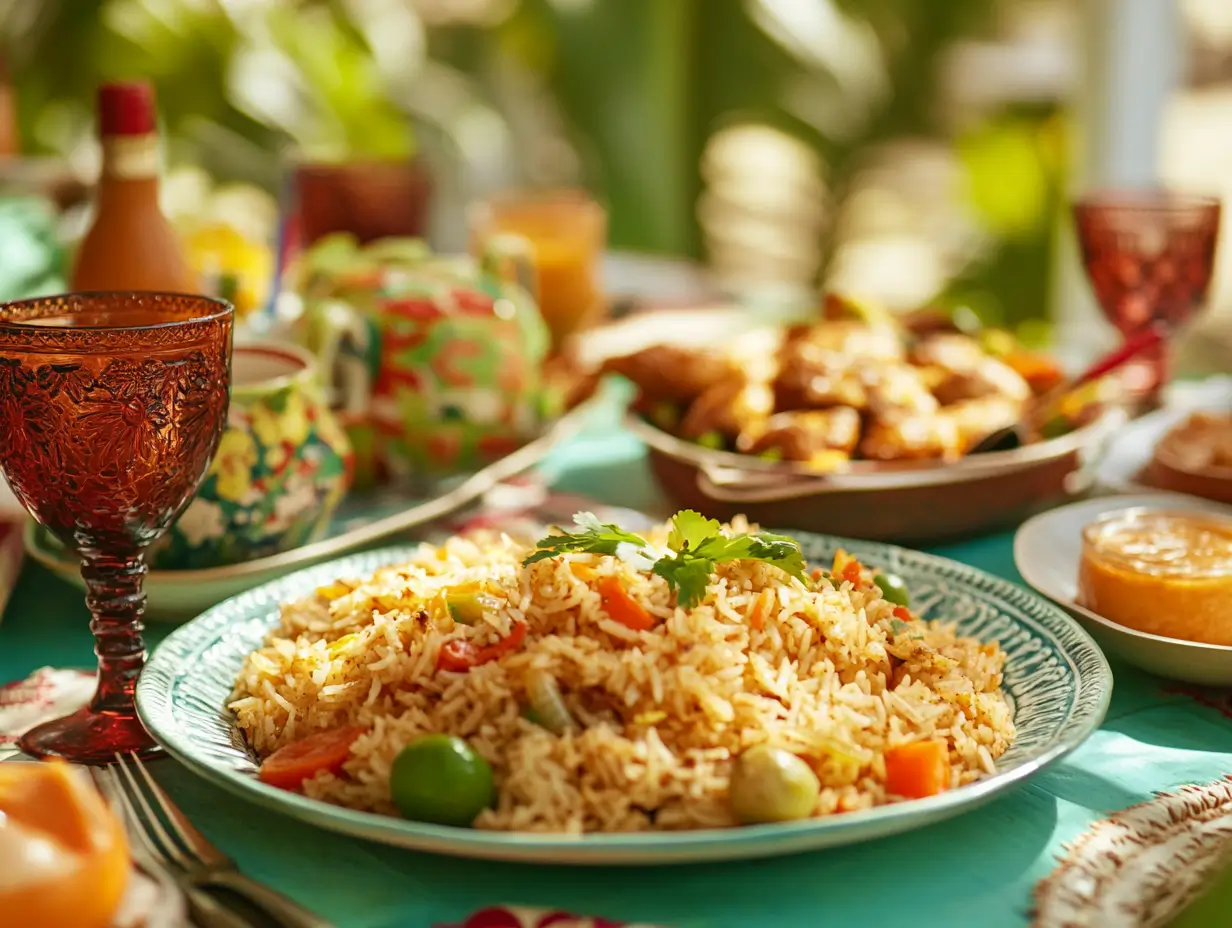Trinirice Delights: 10 Bold Recipes To Try Right Now
Table of Contents
Rice has long been a culinary cornerstone in Trinidad and Tobago, showcasing the island’s cultural diversity and flair for bold flavors. From one-pot wonders to sweet treats, trinirice embodies the essence of Caribbean cooking: vibrant, versatile, and rooted in tradition. This article explores the most iconic rice dishes of Trinidad, tips for perfecting them, and the delightful ways they bring families together at the table. Whether you’re a fan of spicy curries, creamy coconut milk, or zesty herbs, trinirice has something for every palate.
Let’s dive into the world of trinirice and uncover its secrets, dish by dish.
Introduction to Trinirice
What is Trinirice?
Trinirice refers to the collection of rice-based dishes unique to Trinidad and Tobago. Rooted in the island’s diverse cultural heritage, it reflects the influences of African, Indian, Chinese, and European cuisines. While plain rice often serves as the foundation, it’s the creative blends of meats, vegetables, and spices that truly elevate these recipes.
The Role of Rice in Trinidadian Cuisine
In Trinidad, rice isn’t just a side dish; it’s a meal in its own right. Many households rely on rice as a daily staple, pairing it with curried meats, stewed vegetables, or richly spiced gravies. It’s comforting, versatile, and nourishing—qualities that make it indispensable in local cooking.
Diversity and Cultural Influences in Trinidadian Rice Dishes
Trinidadian rice dishes are a culinary melting pot. Dishes like pelau, which blends African techniques with Indian spices, and fried rice, influenced by Chinese immigrants, showcase the island’s dynamic food culture. Sweet rice, or kheer, highlights the deep-rooted Indian traditions brought by indentured laborers. This harmonious blend of influences makes trinirice a celebration of the island’s rich heritage.
Popular Trinidadian Rice Dishes
Pelau: The Quintessential Trini Rice Dish

Pelau is the heart of Trinidadian cuisine, blending African and Indian influences into a single, delicious dish. Often described as a one-pot wonder, pelau is made by caramelizing sugar before adding seasoned meat such as chicken or beef. Once browned, ingredients like pigeon peas, parboiled rice, and fresh herbs are incorporated. Coconut milk, a signature ingredient, infuses the dish with a rich, creamy flavor.
This dish is versatile, commonly served with avocado slices, coleslaw, or fresh cucumber salad. Its bold taste and simplicity make it a go-to for family gatherings and beach picnics.
Dhal and Rice: A Comfort Food Favorite
Dhal and rice is a staple in many Trinidadian households, offering comfort in every bite. The dish consists of boiled white rice paired with dhal, a yellow split pea soup flavored with turmeric, roasted cumin, and fried garlic. Common accompaniments include curried vegetables, fried plantains, or spicy chutneys.
The beauty of dhal and rice lies in its simplicity and adaptability. Whether paired with fried fish or enjoyed on its own, it’s a meal that satisfies both the heart and the stomach.
Fried Rice: A Global Favorite with Trini Flair
Trinidadian fried rice combines the best of Chinese cuisine with local ingredients. While it often features soy sauce, sesame oil, and ginger, Trinis add their unique twist with Scotch bonnet peppers and fresh cilantro. Proteins such as shrimp, chicken, or eggs elevate the dish, making it a hearty main course.
To achieve the perfect fried rice, cooks ensure the rice is day-old and dry, allowing it to absorb the sauces without becoming soggy. This dish is a favorite at Sunday lunches and festive celebrations.
Rice and Peas: Caribbean-wide Classic
Rice and peas are a culinary staple throughout the Caribbean, and Trinidad’s version holds its own. The dish combines pigeon peas or kidney beans with fragrant herbs, garlic, and coconut milk. The creamy texture and rich flavors make it a perfect side dish for jerk chicken, stewed oxtail, or fried fish.
Trinis often enhance rice and peas with local seasonings like thyme and scallions, creating a dish that feels like a warm hug from home.
Creative Rice Recipes in Trinidad
Christmas Rice: A Festive Treat
Christmas rice adds a festive twist to traditional fried rice. With ingredients like cranberries, raisins, and vibrant bell peppers, this dish becomes a feast for both the eyes and the palate. The sweet bursts of fruit balance the savory elements, making it a crowd-pleaser during holiday dinners.
It’s often served alongside dishes like baked ham, macaroni pie, or a fresh garden salad. This recipe showcases how trinirice transforms into an elegant holiday centerpiece.
Bhagi Rice and Ochro Rice: Greens and Grains
Bhagi rice is a savory dish that incorporates dasheen (taro) leaves, coconut milk, and sometimes salted meat like pigtail. The result is a creamy, earthy dish that pairs beautifully with fried fish or grilled meats. Ochro rice, on the other hand, features okra cooked until tender and combined with rice for a flavorful, slimy-free dish.
Both recipes highlight how trinirice embraces fresh, local produce to create nutritious meals.
Turmeric Rice: Spices Meet Simplicity
Turmeric rice may not be as famous as other dishes, but it’s equally delicious. With a base of golden turmeric, cumin, and ginger, this dish bursts with flavor and health benefits. The addition of caramelized onions and chopped herbs adds depth, making it an excellent side for stews or roasted meats.
These creative variations demonstrate how trinirice continues to evolve while staying rooted in tradition.
The Sweet Side of Trinirice
Sweet Rice or Kheer: A Dessert Delight
Sweet rice, also known as kheer, is a cherished dessert in Trinidadian households, especially during festive occasions like Diwali and weddings. This creamy, spiced dish is made by simmering rice with milk, sugar, and spices like cardamom, cinnamon, and cloves. The aroma alone is enough to transport you to a world of indulgence.
Traditionally, kheer is garnished with raisins, almonds, or chopped pistachios, adding texture and a touch of luxury. Its unique blend of sweetness and warmth makes it a comforting dessert for any time of the year.

How Sweet Rice is Made
Making sweet rice involves simple steps that yield exceptional results. First, rice is cooked until tender. Then, evaporated and condensed milk are added, along with sugar and spices. The mixture is stirred continuously to achieve a thick, creamy consistency.
As the spices infuse, the flavors deepen, creating a harmonious blend of sweetness and spice. Whether served warm or chilled, sweet rice is a delightful end to any Trinidadian meal. Its versatility also allows for tweaks like using coconut milk for a tropical twist.
Tips for Cooking Perfect Trinidadian Rice
Techniques for Cooking Fluffy Rice
Perfectly fluffy rice is the foundation of any great trinirice dish. To achieve this, rinse the rice thoroughly before cooking to remove excess starch. This step ensures the grains remain separate. Using the right water-to-rice ratio is equally important—typically, 1.5 cups of water for every cup of rice.
A tight-fitting lid and low heat allow the rice to steam gently, resulting in a soft yet firm texture. Letting the cooked rice rest for 5–10 minutes before fluffing it with a fork enhances the results.
Using Herbs and Spices to Boost Flavor
Trinidadian rice dishes shine because of their aromatic seasonings. Fresh herbs like thyme, cilantro, and scallions add vibrant flavors, while spices like turmeric, cumin, and black pepper provide depth. Don’t shy away from experimenting with coconut milk or allspice for a richer profile.
Secrets to Consistency in Traditional Recipes
Consistency in trinirice cooking comes from practice and preparation. Prepping ingredients beforehand, such as chopping vegetables or seasoning meat, simplifies the process.
Exploring Regional Variations of Trinirice Dishes
Differences in Trinirice Across Trinidad
Although trinirice is enjoyed across Trinidad, the way it is prepared can vary depending on the region. In rural areas, traditional methods, like cooking over an open flame, often add a smoky flavor to dishes like pelau and rice and peas. Additionally, locally grown herbs, such as fine thyme and fresh shadow beni, are commonly used to enhance the flavor of the rice.
Urban areas, on the other hand, tend to incorporate more modern influences into trinirice dishes. For instance, fried rice recipes may include non-traditional ingredients like sweet corn, green beans, or even pineapple chunks for a sweeter, tangier taste.
Incorporating Local Ingredients into Trinirice
The abundance of local ingredients plays a crucial role in shaping regional variations of trinirice. In coastal areas, seafood is often added to dishes, creating unique flavors. Shrimp pelau, for instance, combines the hearty richness of the dish with the light, briny taste of fresh shrimp. Inland regions often rely on poultry or beef, with a focus on deeply spiced, slow-cooked meats.
The use of coconut milk, a staple in many trinirice recipes, also varies. Some regions prefer a lighter consistency, while others opt for a creamier texture that fully coats the rice. These subtle differences contribute to the rich tapestry of flavors found across Trinidad.
Celebrating Diversity Through Trinirice
The regional diversity in trinirice recipes reflects the island’s vibrant cultural heritage. By exploring how these dishes differ across regions, you can appreciate how geography, tradition, and modern influences come together to create something truly special.
For more ways to elevate your rice dishes, consider trying a globally inspired twist like a teriyaki chicken pineapple bowl to bring an international flair to your kitchen.
FAQs About Trinirice and Rice Dishes
What Does Pelau Taste Like?
Pelau, a beloved trinirice dish, is a flavorful mix of savory and slightly sweet tastes. The caramelized sugar used to brown the meat gives the dish a deep, rich flavor. Combined with the creaminess of coconut milk and the earthiness of pigeon peas, pelau is both hearty and comforting. Every bite bursts with spices and herbs, making it an unforgettable experience.
What Is Sweat Rice in Trinidad?
Sweat rice is a term steeped in folklore and tradition. It refers to rice cooked by someone with romantic intentions, often prepared with a special effort to win the affection of another. While there’s no specific recipe for sweat rice, its preparation often involves aromatic herbs and the loving touch of the cook.
What Is the Secret Ingredient in Fried Rice?
The secret to perfect Trinidadian fried rice lies in day-old rice. Using rice that has been refrigerated ensures it doesn’t clump or become mushy when stir-fried. Additionally, the use of sesame oil, ginger, and freshly chopped scallions adds layers of flavor that set trinirice fried rice apart from other versions.
What Gives Chinese Fried Rice Its Flavor?
Soy sauce is the key flavor enhancer in Chinese-inspired fried rice. Trinidadian versions of fried rice often include a dash of oyster sauce or Scotch bonnet peppers to add a local twist, creating a bold and spicy flavor profile.
Conclusion and Call to Action
Celebrating Trinirice: More Than Just Food
Trinidadian rice dishes, collectively known as trinirice, represent more than just meals; they are a celebration of culture, history, and family. Whether you prefer the spiced aroma of pelau, the comfort of dhal and rice, or the sweetness of kheer, there’s a dish to suit every occasion and palate.
Experiment with Trini Recipes at Home
Cooking trinirice is an adventure in flavor and creativity. By experimenting with different ingredients and techniques, you can bring the vibrant spirit of Trinidadian cuisine into your own kitchen. Try using fresh herbs, bold spices, and coconut milk to replicate these dishes authentically.
Join the Trinirice Journey: Share Your Favorites!
What’s your favorite trinirice dish? Share your experiences and recipes with friends and family, or try something new from this guide. With so many delicious options, trinirice offers endless possibilities for culinary exploration.
For even more inspiration, explore other rice-based recipes on cooking sites to broaden your knowledge and try something new. Let’s keep the spirit of trinirice alive and delicious!







